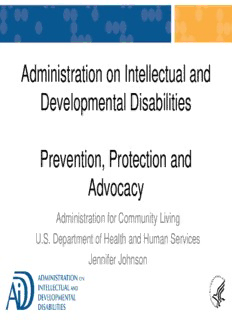
Prevention, Protection & Advocacy - NASUAD PDF
Preview Prevention, Protection & Advocacy - NASUAD
Administration on Intellectual and Developmental Disabilities Prevention, Protection and Advocacy Administration for Community Living U.S. Department of Health and Human Services Jennifer Johnson 1 AIDD Organizational Chart Office of the Commissioner Sharon Lewis Commissioner Aaron Bishop Deputy Commissioner President’s Committee Office of Program Office of for People with Support Innovation Intellectual Disabilities Jennifer Johnson Madjid “MJ” Karimi Ophelia McLain Director Director Team Lead 2 2013 Enacted DD Budget [Enacted after Sequester and L/HHS Rescission] [In millions] • State Councils on Developmental Disabilities $ 70,555 • Protection and Advocacy $ 38,559 • Projects of National Significance $ 7,882 • University Centers on Excellence in Disabilities $ 36,602 • Subtotal, Developmental Disabilities.......................................................... $153,598 4 Key Definitions Developmental Disability • From the DD Act • Has evolved over time through legislation For example, raising the age of onset from 18 to 22; switching o from a list of specific conditions to a more generalized approach focused on a functional definition Intellectual Disability • From the American Association on Intellectual and Developmental Disabilities (AAIDD), the oldest and largest interdisciplinary organization of professionals and citizens concerned about intellectual and developmental disabilities that represents developmental disability professionals worldwide 5 Developmental Disability (DD Act) • A severe, chronic disability of an individual that: – Is attributable to a mental or physical impairment or combination of mental and physical impairments – Is manifested before the individual attains age 22 – Is likely to continue indefinitely – Results in substantial functional limitations in 3 or more of the following areas of major life activity: self-care, receptive and expressive language, learning, mobility, self-direction, capacity for independent living, and economic self-sufficiency – Reflects the individual's need for a combination and sequence of special, interdisciplinary, or generic services, individualized supports, or other forms of assistance that are of lifelong or extended duration and are individually planned and coordinated 6 Intellectual Disability Intellectual disability is a disability characterized by significant limitations both in intellectual functioning and in adaptive behavior, which covers many everyday social and practical skills. This disability originates before the age of 18. “Intellectual functioning” refers to general mental capacity, such as learning, reasoning, problem solving, and so on. American Association on Intellectual and Developmental Disabilities, 2012 7 The DD Act Purpose: • To assure that individuals with developmental disabilities and their families participate in the design of and have access to needed community services, individualized supports, and other forms of assistance that promote self-determination, independence, productivity, and integration and inclusion in all facets of community life 8 Principles of the DD Act • Independence: To have control • Productivity: To work or make other contributions to a household and community • Integration: Right to the same opportunities, services, community resources as all other Americans • Inclusion: Acceptance and encouragement of presence and participation in social, educational, work and community environments. 9 Disability Rights • Full Participation – Legally protected civil rights, independence and control over one’s own life • Integration, inclusion • Prohibiting discrimination on the basis of disability • Eliminating barriers imposed unnecessarily by society based on negative attitudes and misdirected practices • Self-Advocacy • Evolution of terminology – People First language 10 Community Integration “Most integrated setting” • DD Act – Integration and inclusion in all facets of community life • Americans with Disabilities Act – End isolation and segregation of individuals with disabilities • Olmstead Decision – "institutional placement of persons who can handle and benefit from community settings perpetuates unwarranted assumptions that persons so isolated are incapable of or unworthy of participating in community life." – "confinement in an institution severely diminishes the everyday life activities of individuals, including family relations, social contacts, work options, economic independence, educational advancement, and cultural enrichment." 11
Description: